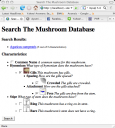Being a code monkey of sorts I have decided to put together something that anyone interested in mushrooms (from complete layman up to professional mycologist) could use: An easy to use mushroom identification database.
My inspiration stemmed from many hours of looking through paper mushroom identification keys that read like crappy choose-your-own-adventure novels (if x, go to page N, if y go to page M). In the digital age, there has to be an easier way to do things, so putting my Library and Information Science skills to work, I’m putting together both an intuitive database to store mushroom identification information along with an intuitive, human-useable interface to retrieve it.

Here’s a screenshot of the concept. This is very far from what the finished product will look like, but it will give you an idea at where I’m going. Instead of going through a key, one simply checks off what features the mushroom they have has one by one (with illustrations to help), and the database compares that combination of features to all of the mushrooms it has on file, and returns them in order of relevance (i.e. highest number of matches first).
The example above only has a handful of characteristics in it, and only one mushroom on file (Agaricus campestris). Once I have in a decent number of characteristics (several hundred it seems like it will be) I’ll make the hierarchical list expandable, so one can jump into whatever section they need more freely, as well as put in ways to remove fields that really can’t truly be check-off searched (like common names, etc).
I’ll post more as I come up with it.
Peace,
-Steve

















